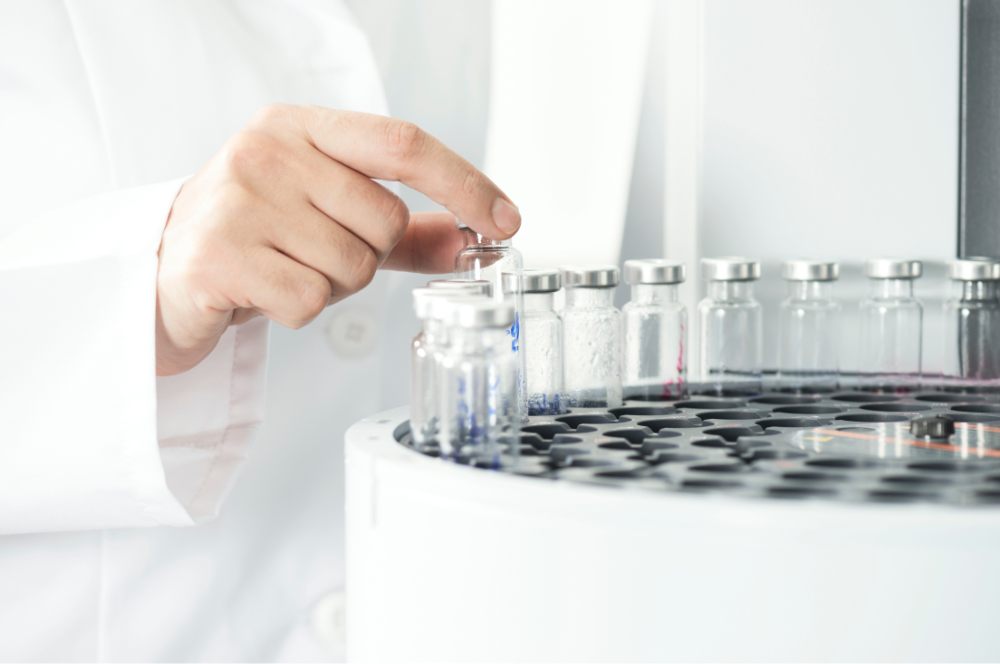
While rotary evaporators are a simple solution for concentrating one sample at a time, two types of concentrators are typically utilized for processing multiple samples at once: nitrogen blow down and centrifugal.
Centrifugal concentrators, such as the SpeedVac, are a popular choice for concentrating DNA and other molecular extracts because these units provide efficient solvent removal at low temperatures due to the application of vacuum.
How to use a centrifugal evaporator:
1. Sample Placement: Samples are placed in a rotor, typically in vials or microplates. This rotor is located inside the main chamber of the evaporator.
2. Vacuum Creation: The chamber is sealed, and a vacuum is created inside of it. The vacuum reduces the boiling point of the solvent, allowing it to evaporate at lower temperatures. This is particularly useful for heat-sensitive materials as it minimizes the risk of thermal degradation.
3. Centrifugation: While under vacuum, the rotor spins at high speeds. This centrifugal force ensures that the samples are held in the bottoms of the tubes or wells, preventing spillage and loss of samples during the evaporation process. It also helps distribute the samples evenly for more uniform drying.
4. Heating (Optional): Some models of centrifugal evaporators include heating to further lower the boiling point of the solvent. Controlled heating can speed up the evaporation process.
5. Solvent Recovery (Optional): In some setups, the evaporated solvents can be condensed and recovered. This is done using a cold trap or condenser that cools the vapor, turning it back into a liquid, which is when collected.
Choosing between the SpeedVac (or CentriVap) and the N-EVAP
Deciding between using a nitrogen blow down system, or a centrifugal evaporator like the SpeedVac, often depends on the specific requirements of the sample and the desired outcomes. Here are some scenarios where nitrogen blow down might be a better approach:
Sample Sensitivity - Nitrogen blow down is a gentler process as it doesn't involve spinning the sample, which can be advantageous for very delicate samples that might be disturbed or damaged by the physical forces exerted in a centrifugal evaporator.
Volatile Solvents - For very volatile solvents, nitrogen blow down can be effective and efficient. The gentle stream of nitrogen can effectively evaporate solvents without the need for the lower pressures used in centrifugal evaporation, which might lead to bumping or splashing of the sample.
For more information on evaporating volatile, chlorinated or corrosive solvents, please refer to When Nitrogen blowdown is Preferable Over Centrifugal Evaporation.
Small Sample Volumes - Nitrogen blow down can be more controllable for very small volumes that might risk being lost under the vacuum and centrifugal forces within a SpeedVac. Directing a stream of nitrogen onto a small volume can concentrate the sample without significant loss.
Thermal Sensitivity - If a sample is particularly sensitive to heat, both types of evaporators can provide effective sample preparation. Nitrogen gas can be delivered at ambient temperatures, whereas centrifugal evaporators can rely on the force of spinning to remove the solvent.
However, some laboratories switch from SpeedVacs to blow down dry evaporators because they find that the higher temperature provided by the nitrogen evaporator provides better evaporation rates. To learn more, please refer to Centrifuge Supplanted by Faster Nitrogen Blow Down.
Simplicity and Equipment Availability - Nitrogen blow down systems are generally simpler and may be more readily available in some labs. They require less setup and maintenance compared to a centrifugal evaporator, which needs a vacuum system and potentially a cooling system as well.
Throughput Requirements - While both evaporator types are excellent for handling multiple samples simultaneously, for individual samples or when throughput is not a concern, the simplicity of a nitrogen blow down setup might be preferred.
Choosing the right evaporation method depends on balancing factors like sample type, solvent properties, volume, sensitivity to heat and physical forces, and the specific requirements of subsequent analytical procedures.
For more information on our nitrogen evaporation solutions or to discuss your specific application, please contact our sales team through email at sales@organomation.com. For a more immediate response, feel free to contact us using our live chat feature, available during our regular business hours.
